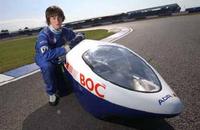Hydrogen Powered Vehicle - Most Efficient Vehicle Ever to Travel on Wheels?
July 4, 2005
A new British hydrogen vehicle will attempt the world efficiency record using a driver aged just 13
BOC's dolphin-shaped eco-marathon vehicle, the BOC Ech2o is today (Monday July 4) ready to attempt the world fuel efficiency record.
The BOC Ech2o has been designed with a simple goal to demonstrate fuel efficiency.
But unlike most other eco-marathon vehicles that run on petrol or diesel, the BOC Ech2o's driving force comes from electricity, created in a hydrogen fuel cell.
The car could travel around the world on less than the equivalent of two gallons of petrol, using 25 watts - a fraction of the power a light bulb uses.
It could also be the most efficient vehicle ever to move on wheels and, as its only emission is water, the car heralds a new age of clean virtually silent road travel, according to experts.
The vehicle is a joint development project by several UK organisations. BOC designed the hydrogen storage system; OSCar Automotive designed the body and running gear; and the electric power train has been developed by Oxford University.
But don’t expect to get anywhere quickly yet. The car travels at 30 miles per hour.
The BOC Ech2o car, driven by Jack Dex, 13, of Southam College, Warwickshire, will attempt to break the world fuel efficiency record of over 10,000 miles per gallon next week, during the Shell Eco Marathon at Rockingham Raceway in the Midlands.
The youngster was chosen because he is small and light enough to control the vehicle, without weighing it down – and because of his experience as a junior TKM Kart driver.
John Carolin, BOC’s Global Director Sustainable Energy, said: “It sounds unbelievable how little power is used to keep the BOC Ech2o moving, but it demonstrates the impact of careful design and is a valuable lesson for car makers in the future."
The car’s body is described as dolphin-shaped and has been crafted by racing car designer Hugo Spowers using carbon fibre and lightweight aluminium. Spowers' Oscar Automotive Company is also responsible for the aluminium chassis, suspension and steering systems.
Oxford University School of Engineering Science is providing the power electronics and driver control system.
Dr Malcolm McCulloch, a lecturer in the Department of Engineering Science, said: “This has been a fantastic experience for students to participate in such a challenging project.
"Sustainable development is very popular with students and this project has provided a lot of stimulus amongst the student community.”
Bronkhurst UK are providing a compact and light-weight hydrogen mass flow controller that will be used to verify the car’s performance.
Carolin added: “The lessons from this and other projects will show that hydrogen fuel cell powered vehicles could be a practical, attractive and a viable economic alternative to diesel or petrol fuelled vehicles.”
The BOC Ech2o car runs on a hydrogen fuel cell, the concept of which was invented in 1839 by Sir William Grove. The process of generating electricity through fuel cells is similar to using a battery, but where a battery relies on an internal chemical fuel supply; the fuel cell can be fed continuously by an external energy storage tank.
Last year the BOC Gh2ost tried and failed to beat the world fuel efficiency record and the BOC Ech2o has been developed for the new attempt. The record is held by the PAC-Car II – a hydrogen-fuelled Swiss vehicle that travelled the equivalent of 5,385 km/per litre at a testing track in France recently.
HYDROGEN FACTS
*
Hydrogen is the simplest, lightest and most abundant element in the universe
*
It is colourless, odourless and tasteless and is easily made
*
Hydrogen’s only emission is water vapour
*
Hydrogen improves air quality and reduces greenhouse gases
*
Internal combustion car engines can be adapted to burn hydrogen cleanly
*
Hydrogen spills remove themselves because the gas is so light



